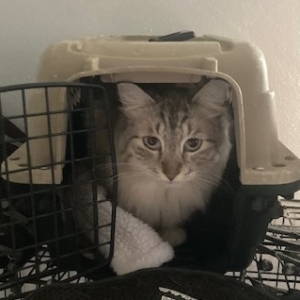Commitment to Care: Training Your Cat To Like The Carrier
When asked, ‘what is the one thing your cat dislikes the most’, 75% of cat parents say the carrier. That is also the number one reason why people put off taking their cats to the veterinarian for their annual or biannual checkups. There may be a time that you will need to evacuate your home during an emergency.

Training your kitty to accept and get used to the carrier before this happens will make an already stressful situation much easier. The team at Pinellas Animal Hospital are here to help you prepare for situations like this and would like to give you some tips on how to get started by positively introducing the carrier to your cat.
It is best to start carrier training the day you bring your new kitty home as it is important that the carrier is always presented as a “safe place”. If a cat only goes into their carrier to go to the veterinary office or in other stressful situations, they will automatically associate it with upset and stress.
To begin training your cat leave the carrier out with the door open with some soft comfy bedding inside. Let the cat go in and out as they please and leave them alone. Put a couple of treats on the blanket or even a bit of catnip to help coach them in. Never shut the door while they are in there. No need to call the cat or continuously pat the bedding saying, “come inside it’s nice in here” or “it’s ok”, just allow them to do it all on their own.
You will eventually see your cat going inside, relaxing, and sleeping on its own. Once they are comfortable with sleeping in there you can quietly shut the door but don’t lock it, and open it right back up. Each day you can leave the door shut a bit longer. Once you are able to shut the carrier door completely and your cat is comfortable, you can start working on moving it.
 To start this, first gently lift the carrier up then back down. When your cat is ok with that, you can move the carrier to another area of the room and eventually to another room. The key is to get your cat used to it one step at a time before moving on, this will take time and patience, but the end result will make it all worthwhile. Once your cat is comfortable moving from room to room in the house while in the carrier, you can then start placing the carrier in your car and then taking it back inside. When putting the carrier in your car, if possible, place it on the floor behind the front seats. If you must put the carrier in the cargo area, make sure it is buckled in, so it doesn’t go tumbling around. Next, start taking your cat on short car rides around the block then back home until he or she is comfortable with the movement.
To start this, first gently lift the carrier up then back down. When your cat is ok with that, you can move the carrier to another area of the room and eventually to another room. The key is to get your cat used to it one step at a time before moving on, this will take time and patience, but the end result will make it all worthwhile. Once your cat is comfortable moving from room to room in the house while in the carrier, you can then start placing the carrier in your car and then taking it back inside. When putting the carrier in your car, if possible, place it on the floor behind the front seats. If you must put the carrier in the cargo area, make sure it is buckled in, so it doesn’t go tumbling around. Next, start taking your cat on short car rides around the block then back home until he or she is comfortable with the movement.
Once comfortable you can start lengthening your car rides and try going to your veterinary hospital. Bring your cat inside while in the carrier and have the staff give him or her some treats and love while in the carrier. We call this a ‘Happy Visit’, most vet hospitals will be happy to assist you with this part of carrier training. This will help take the fear out of visiting the veterinarian in the future.
The main thing with this training is to remember to keep the carrier out and let your cat have open access to it. This could take a few days to even a few weeks. Eventually your cat will accept the carrier as their safe place. If you must travel with your cat, whether it is to see their veterinarian or for a trip out of town, carrier training will make it much easier for you both to navigate these special circumstances. If you need further assistance with this or anything else, we are always happy to help. Stop by anytime, call, or text 727-546-0005.
